System Analysis and Design Assignment: Case Study Analysis of Meet Fresh Easy
Question
Task: Case Study: Meet Fresh Easy (MFE)
Background:
Meet Fresh Easy (MFE) is a type of e-business exchange that does business entirely on the Internet. The company acts as a clearinghouse for buyers and sellers of fresh food.
To offer fresh food for sale, a person must register as a seller with MFE. The person must provide a current physical address and telephone number as well as a current e-mail address. The system then maintains an open account for this person. Access to the system as a seller is through a secure, authenticated portal.
A seller can list fresh food on the system through a special Internet form. The form asks for all the pertinent information about the fresh food: its category, its packaging/weight, and the asking price. A seller may list as much fresh food as desired. The system maintains an index of all fresh food in the system so buyers can use the search engine to search. The search engine allows searches by name, brand, category, and keyword.
People who want to buy fresh food come to the site and search for the food they want. When they decide to buy, they must open an account with a credit card, and use this card to pay for the quantity they purchase. The system maintains all this information on secure servers.
When a purchase is made, MFE sends an e-mail notice to the seller of the fresh food that was chosen as well as quantity and payment information. It also updates the quantity of fresh food after the sale. The system maintains an open order until it receives notice that the order has been shipped. After the seller receives notice that a listed fresh food has been sold, the seller must notify the buyer via e-mail within 48 hours that the purchase is noted. Shipment of the order must be made within 24 hours after the seller sends the notification e-mail. The seller sends a notification to the buyer and MFE when the shipment is made.
After receiving the notice of shipment, MFE maintains the order in a shipped status. At the end of each month, a check is mailed to each seller for the sale orders that have remained in a shipped status for 30 days. The 30-day waiting period exists to allow the buyer to notify MFE if the shipment doesn’t arrive for some reason or if the product isn’t in the same condition as advertised. If they want, buyers can enter a feedback rating. The feedback rating is an indication of how well the seller is servicing purchases. Some sellers are very active and use MFE as a major outlet for selling fresh food. Thus, a feedback rating is an important indicator to potential buyers.
System Analysis and Design Assignment Part A – Essay
Question 1: Writing
MFE are unhappy with their current system and have asked you to oversee the System Development Life Cycle and plan the specific approaches would be suitable for developing the new system for MFE.
The manager of MFE has worked in systems development some time ago and is convinced that a traditional waterfall approach would be the best approach. However, your experience makes you believe an agile development methodology would be the best approach.
Write an essay to explain what specific type of approach would be suitable for developing this project. The essay should:
• discuss various systems development approaches and relevant methodologies for development. State under what circumstances each methodology would be used and how they may be applied to your case study project.
• recommend and justify your chosen methodology to develop the project.
Your target audience are executive business people of the company and have limited understanding of computer terminology.
In the essay, you need to
• Utilise creative, reflective and critical thinking to develop, evaluate and justify innovative solutions to business case study,
• Demonstrate skills in finding and appraising credible and audience appropriate literature to support your analysis and design solution.
Your essay should be around 2,000 words (excluding the references) in length.
Appropriate referencing is required. The textbook Satzingeret. al is a valid resource, however it is expected that at least five (5) other resources will also be used.
Part B - Modelling and Diagramming
Review the case study and answer the following questions with reference to the information in the case study.
Do NOT extend the scope for any of the following solutions beyond that specifically described in the case study above.
You are permitted to make reasonable assumptions where necessary but these should be noted.
It is recommended that you review all documentation for this case study before finalizing any single solution. Ensure that the required consistency has been included within and between each question solution.
Question 2: Use Case Modelling
a) Event/Use case table (10%)
Review the case study and prepare an event/use case table for the information system to support the business processes as described. Use the even decomposition technique to identify events that the system must respond, and then identify related use cases and actors. Use at least the following headings for the table:

b) Use Case Diagram (5%)
Review the case study and your use case table solution from Question 2a above to prepare a Use Case diagram for the project. Solutions must follow the methodology as outlined within the Satzinger et al (2016) textbook. Solutions are expected to align with the components as shown in figures 3-12 to 3-15.
c) Use Case Description (10%)
Select 1 use case from Question 2a and prepare a fully developed Use Case description for it. Solutions must follow the methodology as outlined within the Satzinger et al (2016) textbook. Solutions are expected to align with the components as shown in figure 5-2.
d) System Sequence Diagram (10%)
Review the case study and the selected use case in Question 2c to prepare a System Sequence diagram fully developed Use Case description for it. Solutions must follow the methodology as outlined within the Satzinger et al (2016) textbook. Solutions are expected to align with the components as shown in figure 5-7 to 5-11.
Question 3: Domain Modelling
a) Domain Model Class Diagram (15%)
Review the case study to prepare a domain model class diagram for the project. Solutions must follow the methodology as outlined within the Satzinger et al (2016) textbook. Solutions are expected to show:
• The class name and attributes list for each class and sub class as required
• All required associations
• All attributes as specifically mentioned in the case study must be reflected
• Other attributes as needed to support the described functionality.
It is not necessary to show methods, however you may include them if you wish. Solutions are expected to align with the components as shown in figures 4-16 to 4-25.
b) Design Class Diagram (10%)
Select 2 classes from Question 3a and prepare a Design Class diagram for each of them. Each of these design class diagrams are expected to have a complete attributes list and a comprehensive methods list which supports the specified functionality as described in the case study.
Solutions must follow the methodology as outlined within the Satzinger et al (2016) textbook. Solutions are expected to align with the components for the ‘Design class diagram Student’ as shown on the right hand of figure 12.4.
Question 4: Design System Architecture
a) Deployment diagrams
Review the case study and design a deployment plan for the final software product. Demonstrate your design with a Deployment Diagram, which is accompanied by an explanation/discussion with 200 – 300 words. You are permitted to make reasonable assumptions where necessary, but these should be noted.
Solutions must follow the methodology as outlined within the Satzinger et al (2016) textbook. Solutions are expected to align with the components as shown in figure 7-15 and 7-19.
Answer
System Analysis and Design Assignment Part A – Essay
Introduction
The essay is mainly based upon establishing a new system development approach for Meet Fresh Easy (MFE); the company undertakes the business of serving fresh food. MFE generally carries out e-business exchange which means the process of sales and marketing is conducted with an online booking facility. The main aim of the essay is to present a detailed evaluation of various types of system development approaches which could be followed in case of improving various business policies and also growth under various sectors. The system which MEF is using is quite unsatisfied, due to which some specific changes are needed to apply based upon various system development approaches which would help in improving the system development life cycle of the company. Some of the most appropriate system development approaches are described under this report which would help in having a better understanding of various system approaches and also how to implement the approach for developing a new system. Along with all such factors some tools, models, and techniques are also mentioned under this essay which would help MFE to have a clear analysis of the newly developed system along with some methodologies which are highlighted within the essay.
Systems development approaches and methodologies
In the case of establishing a new system development plan, various fundamental approaches need to be highlighted in case of creating a new system or improving the previous system which MEF has implemented for continuing their business. The model of system development mainly consists of two fundamental approaches which are known as the Predictive approach and Adaptive approach; these two approaches would mainly help in improving the marketing system of MEF Company (Borénet al., 2017).
The predictive approach is mainly a type a system development methodology that helps in developing a planned and successful project which would also have the facility of future up-gradation as per new requirements added by the company. Various new processes are also involved under the traditional predictive approach some of them are; project planning, analyzing the project, designing the system as per mentioned requirements, upgrading previous systems, as well as deploying some older approaches. One of the most interesting models which come to the predictive approach is the Waterfall model; this is one of the most well-known models for developing such a system (Tarczewski and Grzesiak, 2015).
The predictive approach mainly requires proper planning of design and creation which is considered as one of the major objectives of implementing such an approach. According to research, it could be identified that the predictive approach is one of the most effective ways of developing business, in the case of MEF; the predictive approach would help in making right market predictions which would avoid huge business loss as well as help the company in delivering superior service. In the case of small scale businesses applying such an approach is a challenging factor as it holds limited data management. By using such an approach the company can also gain a huge amount of customers (Pesquitaet al., 2018). In case of implementing such a system, MEF must have a large scale business for managing various processes involved under the approach. Along with all such factors, the predictive model mainly helps in generating a working software application by using which the company can make particular changes as per their requirements. Waterfall Model is mainly considered as one of the most specific models under the predictive approach, it is also denoted as the linear sequential life cycle model, this type of model mainly helps to evaluate the software development process under a linear sequential flow, such that every single development process could be completed only if the previous process is fully completed. One of the major advantages of the waterfall model is, it does not get overlapped, and this system is mainly used for developing various innovative software applications. According to research, it could be examined that in the case of following the waterfall model one can complete any kind of task only if the output of the previous phase is declared (Kramer, 2018).
The waterfall model could be implemented using various methodologies, some of the most important steps include; requirement gathering, followed by designing the system model, implementation of various kinds of data which is gathered, along a process of testing and deployment of various unwanted elements. The Waterfall model can also be implemented as this is considered as one of the most ancient and productive models for system development. The following model would also help the online system application to improve its performance and would also help customers to provide valuable and positive feedback. In the case of implementing such a development model, the company needs to have a strong growth under various marketing sectors. Along with all such factors, for using such a model the company must have well qualified and skilled employees such that they can easily understand various new methodologies used under the newly developed system (Savard and Cyr, 2018).
The adaptive approach is mainly focused on finding new alternative ways by using which various objectives of the company could be achieved. According to research and development, it could be examined that the adaptive approach is mainly used for predicting various new success factors that would help MEF to have solved various issues regarding online system applications. The main objective under this approach is, it mainly helps in finding various alternative tools and techniques for monitoring various processes carried out within the system. In the case of establishing a new system development plan, the adaptive approach is considered as one of the most appropriate solutions which would help the company to overcome various challenging factors (Atta et al., 2018). In the case of implementing adaptive system development model, there are various factors which needs to be highlighted, some of the most specific steps for approaching the model includes, this is one of the most responsive and highly upgraded systems which generally requires a highly configured computer system, by using after which certain amount of useful data could be gathered. Along with such factors, the adaptive approach would allow the online system to function smoothly such that every single process could be executed accurately. In the case of implementing such an approach, incremental development and walking skeleton are two major requirements for adopting such a system, as these two approaches would allow the system to complete the system structure by using the bare-bones functionality. Thus it could be identified as one of the perfect solutions for improving MEF’s online e-e-commerce application (Chhabraet al., 2018).
Agile methodology is mainly considered as group software development methods which are mainly dependent upon iterative development, which means that every requirement and solution could be gathered by various teams involved in the management team. Agile projects are generally carried out disciplined project management steps which would mainly help members in developing a strong team spirit, self-organization as well as accountability of leadership quality. According to research, it could be identified that the agile development process is mainly combined with various concepts of Agile Manifesto; Agile mainly processes under the adaptive approach (Mahadevanet al., 2015).
In the case of implementing the agile methodology, there are various factors which need to be considered, some key steps of implementing such method are; the company must always try to apply any kind approach based upon its requirements, second, the team leader must clearly define various team roles, then comes estimation of effort which is quite unpredictable in case of the agile system. Moreover, in the case of implementing agile methodology there must an accurate scope, cost, and quality analysis of the various requirements which need to be fulfilled, along with all such factors various limitations must be strictly followed and must not be changes at any cost. Managing tension is also another approach that needs to follow by the food company for adopting agile methodology. This method also involves the facility of recheck after completion of the overall task. Thus following are various approaches by using which we can implement an agile methodology for the company.
Under agile methodology, various techniques need to be incorporated in case of developing the online system application. The unified process has been considered as a specific procedure, which is applied under the initial stage of the system development plan the steps involved under the process are the inception phase under which the project is started, second is elaboration under which various requirements are gathered, then comes construction which is responsible for building the system and finally it also includes transitions phase. Under the second stage, Extreme programming or EP is carried out, which is mentioned as the most appropriate practice for developing software applications, some of the key factors of XP includes frequent communication, specific feedback facility from required stakeholders, followed by simplicity in proving the solution and finally it also allows developers to make changes according to their wish. Scrum is mainly considered as a framework which helps team members to coordinate with each other and work together (Srivastavaet al., 2017). Scrum is mainly considered as part of the agile approach as it mainly helps in defining various tools, meetings, and job roles which would help the team leader to manage his team accordingly. Scrum would also help the company to gain various new methods as well as it would also help in improving the e-commerce site based upon specific system requirements. Thus following are some approaches that could be applied in case of developing a new system application.
Recommendations and justification of the chosen methodology
However, after completing research about different approaches and methodologies, along with some significant tools, techniques, models, and practices, it can be said that for this system development project MFE should engage the adaptive approach along with the agile methodology. However, the following discussion will justify the reasons behind choosing these two over the traditional waterfall method as well as the predictive approach. Several significant advantages are present there, which are having the capability of justifying this selection of agile methodology over the traditional waterfall methodology, such as the recommended methodology allows a system development project to make changes easily, quickly, and dynamically according to the current needs as well as the requirement of the users(Cram and Marabelli, 2018). In addition to that, it always focuses on the features, which will help the project to create higher customer value, and it includes a short-fixed schedule, which will enable this project to take instant feedback concerning the end-users as well as the capability of moving project deliverables towards production. Furthermore, it is also beneficial in the case of the project team. Moreover, this specific and significant methodology includes several regular check-insas well as a demonstration with the project, which will allow them to acknowledge the required changes and make the changes rapidly. Apart from that, this approach engages the end-users more with the project, which allows the project for being error-free and the product for being successful and adequate, whether the waterfall approach does not much encourage the stakeholder engagement (Kasauli et al., 2017). In concern of these reasons, it is better to adopt the agile methodology and adaptive approach in this system development project in MFE.
Conclusion
This entire essay depends on the case study of the Meet Fresh Easy Company, which is an online food selling company and likes to implement a new system for turning their business performance into an excellent level and managing the entire business process suitably. However, initially, this essay critically evaluates the different approaches and methodologies, which are applicable in this chosen scenario, along with that shows how those specific approaches and methodologies can be applied. However, after the proper evaluation, it recommends a specific methodology for this project with proper justification for choosing it over the other methodologies.
Part B - Modelling and Diagramming
2. Use Case Modelling
a) Event/Use case table
|
Event |
Type |
Use Case |
Actor |
Brief description |
|
A newly registered consumer seeks to register a credit card |
External |
Credit card registration |
Consumer and admin |
In this event, a newly registered consumer request for approving a credit card account for processing further payments |
|
A buyer submits rating as a feedback |
External |
Feedback submission |
Consumer and admin |
In this event, an existing customer gives their own feedback on a specific product or order, and the system admin checks the feedback later and gives a response when it is necessary. |
|
A buyer need to do the payment when they purchase any product from the application |
Internal |
Payment process |
Payment manager and consumers |
When a buyer purchases one or multiple products from the application, they have to go through from this process. In this case, only after the confirmation of the payment manager regarding the buyer’s payment the order has been confirmed from MFE. |
|
The consumer wants to buy a specific item |
Internal |
Order confirmation |
Admin and consumers |
In this case, the consumers initially check for the available items and make an order for the available products. Later the admin confirms the order when the payment has been confirmed from the payment manager. After confirming the order the admin also informs the seller about the new order. |
|
A new user wants to register himself or herself with the organisational application |
External |
Consumer registration |
Consumers |
In this case, the new consumers usually submit asked details to the application, and then the admin confirms the registration through verifying the validity of the given details. |
|
A new seller wants to register himself or herself with the organisational application |
External |
Seller registration |
Seller |
In this case, a new seller submits asked details in the registration form, and then the admin confirms the registration through verifying the validity of the given details. |
|
The seller wants to inform the admin and the buyer, when an order is shipped successfully |
External |
Product delivery notification |
Seller, admin, and consumers |
Once a seller delivers an ordered product to the doorstep of the consumer, the seller informs about the successful shipment to both, the consumer and the admin. |
|
A seller wants to modify in the product list of his or her store in the application |
External |
Product list update |
Seller |
Usually, after registration of the new sellers, they need to update their product list according to the availability of the product in their store. |
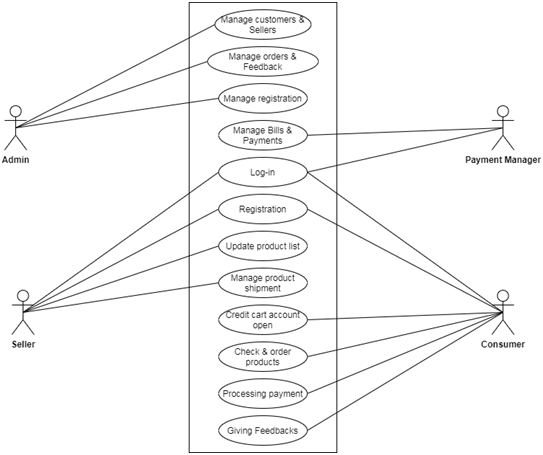
Figure 1: Use case diagram
(Source: created by the learner)
c) Use Case Description
|
Use case name |
Consumer Registration |
|
|
Scenario |
Opening a new account for new customer |
|
|
Trigger |
A new user wants to register himself or herself with the MFE application |
|
|
Brief description |
The new user registershimor herby entraining the valid details that are asked in the registration form. |
|
|
Actors |
Consumer |
|
|
Stakeholders |
Admin and consumer |
|
|
Pre-conditions |
· The users need to provide all details asked by the application. · The details should be valid. · The details should not be matched with the existing details in the application’s database. |
|
|
Post-conditions |
· Customer details must be saved. · A customer account must be created. |
|
|
Activity flow |
Actor |
System |
|
1. The customer enters the asked details to the customer. 2. Submit the details |
1.1 The system checks the validity and originality of the given details. 2.1 The system saves the details. 2.2 The system creates a new account. 2.3 The system provides the account credential to the consumer. |
|
|
Exception |
1. The details are not valid. 2. The details matched with the existing details in the database. |
|
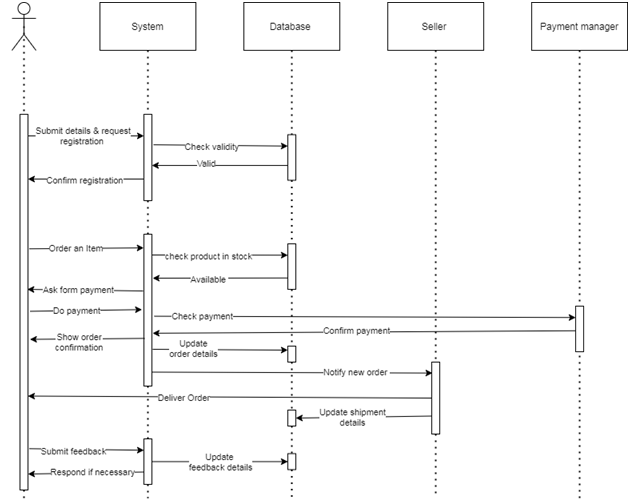
Figure 2: System sequence diagram
(Source: created by the learner)
3. Domain Modelling
a) Domain Model Class Diagram
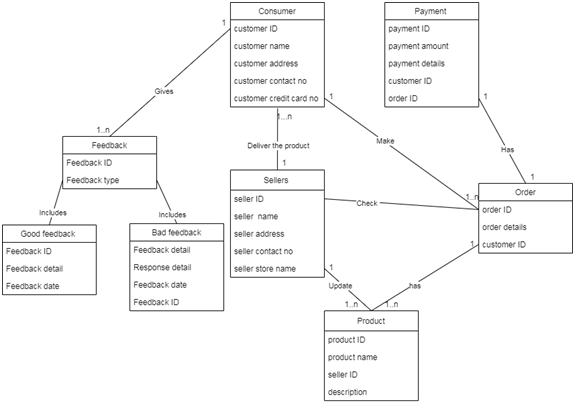
Figure 3: Domain class diagram
(Source: created by the learner)
b) Design Class Diagram
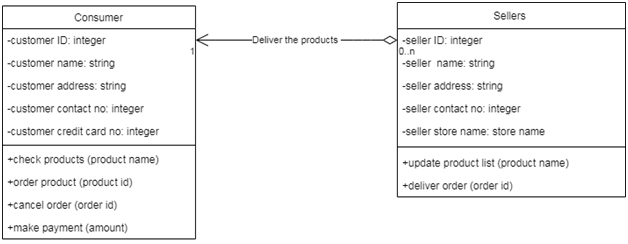
Figure 4: Class diagram
(Source: created by the learner)
4. Design System Architecture
a) Deployment diagram
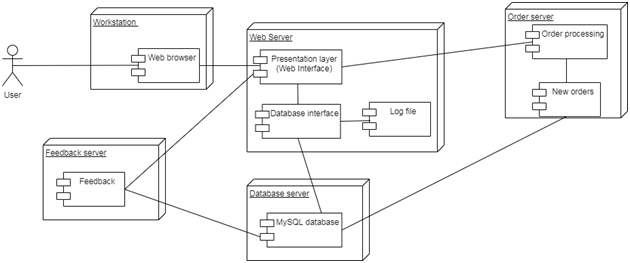
Figure 5: Deployment diagram
(Source: created by the learner)
The main purpose of developing a deployment diagram is to demonstrate the deployment view regarding a complete system. It is also known as a component diagram, since several components of the complete system are mainly deployed in this diagram. However, different sorts of nodes are included in this deployment design, from which the physical hardware is considered as a major one that is capable of being used in order to deploy the proposed system by MFE. Moreover, its incorporation will be highly beneficial as it monitors different major parameters, e.g. performance, probability, scalability, along with the maintainability as well. This deployment diagram also shows the connection and purpose of specific nodes. However, here, in this case, the customers and sellers of MFE, both use mobile devices and the internet for accessing the new application of MFE. And for caching the internet they use routers. Furthermore, several data servers are engaged there, for the purpose of sharing data as well as a resource, and the database is engaged for storing different sorts of data. Within this deployment diagram, customers move to the E-menu for the purpose of checking the products as well as ordering that product, which are stored in the database.
Reference List
Atta, A., Abbas, S., Khan, M.A., Ahmed, G. and Farooq, U.,( 2018). An adaptive approach: Smart traffic congestion control system. Journal of King Saud University-Computer and Information Sciences.https://www.sciencedirect.com/science/article/pii/S1319157818308565
Borén, S., Nurhadi, L., Ny, H., Robèrt, K.H., Broman, G. and Trygg, L., (2017). A strategic approach to sustainable transport system development–part 2: the case of a vision for electric vehicle systems in southeast Sweden. Journal of Cleaner Production, 140, pp.62-71.https://www.sciencedirect.com/science/article/abs/pii/S0959652616002250
Chhabra, A., Vashishth, V. and Sharma, D.K., (2018). A fuzzy logic and game theory based adaptive approach for securing opportunistic networks against black hole attacks. International Journal of Communication Systems, 31(4), p.e3487. https://onlinelibrary.wiley.com/doi/abs/10.1002/dac.3487
Cram, W.A. and Marabelli, M., (2018). Have your cake and eat it too? Simultaneously pursuing the knowledge-sharing benefits of agile and traditional development approaches. Information & Management, 55(3), pp.322-339.https://www.researchgate.net/profile/Marco_Marabelli/publication/319163712_Have_Your_Cake_ and_Eat_it_Too_Simultaneously_Pursuing_the_Knowledge-Sharing_Benefits_of_Agile_and_Traditional_Development_Approaches/links/59dcfe8aaca27203e9c4a529/Have-Your-Cake-and-Eat-it-Too-Simultaneously-Pursuing-the-Knowledge-Sharing-Benefits-of-Agile-and-Traditional-Development-Approaches.pdf
Kasauli, R., Liebel, G., Knauss, E., Gopakumar, S. and Kanagwa, B., (2017, September).Requirements engineering challenges in large-scale agile system development.System analysis and design assignment In 2017 IEEE 25th International Requirements Engineering Conference (RE) (pp. 352-361).IEEE.https://dl.gi.de/bitstream/handle/20.500.12116/21139/A1-40.pdf?sequence=1
Kramer, M., (2018). Best practices in systems development lifecycle: An analyses based on the waterfall model. Review of Business & Finance Studies, 9(1), pp.77-84.https://papers.ssrn.com/sol3/papers.cfm?abstract_id=3131958
Mahadevan, L., Kettinger, W.J. and Meservy, T.O., (2015). Running on hybrid: Control changes when introducing an agile methodology in a traditional “waterfall” system development environment. Communications of the Association for Information Systems, 36(1), p.5.https://aisel.aisnet.org/cais/vol36/iss1/5/
Pesquita, A., Whitwell, R.L. and Enns, J.T., (2018). Predictive joint-action model: A hierarchical predictive approach to human cooperation. Psychonomic bulletin & review, 25(5), pp.1751-1769.https://link.springer.com/article/10.3758/s13423-017-1393-6
Savard, A. and Cyr, S., (2018). A Waterfall Model for Providing Professional Development for Elementary School Teachers: A Pilot Project to Implement a Competency-Based Approach. Global Education Review, 5(3), pp.165-182.https://ger.mercy.edu/index.php/ger/article/view/408
Srivastava, A., Bhardwaj, S. and Saraswat, S., (2017), May. SCRUM model for agile methodology. In 2017 International Conference on Computing, Communication and Automation (ICCCA) (pp. 864-869).IEEE.https://ieeexplore.ieee.org/abstract/document/8229928
Tarczewski, T. and Grzesiak, L.M., (2015). Constrained state feedback speed control of PMSM based on model predictive approach. IEEE Transactions on Industrial Electronics, 63(6), pp.3867-3875.https://ieeexplore.ieee.org/abstract/document/7317575












